What Is Phase 4 of Aviation SMS Implementation

Phase 4 of SMS implementation is all about following through on designing your SMS, and moving forward with actually using the created resources and monitoring your SMS. For example, in Phase 3 of SMS implementation you are required to create KPIs, and in Phase 4 you are required to monitor them.
Many aspects you created in Phase 3 are fulfilled in Phase 4 by assuring that they function in actual operations. Thus, Phase 4 is largely concerned with:
- Verifying that your Safety Assurance process is working as designed;
- Ensuring that your SMS is operational, rather than simply documented; and
- Following through on practicing continuous improvement.
Phase 4, like Phase 3, is a major hurdle in implementing your SMS. Oftentimes, it will take 1-2 years to fully implement it.
The main takeaway is that proving you are complete with Phase 4 of aviation SMS is that you have paper trails and other evidence that prove you are completing Phase 4 requirements.
KPI Monitoring Process Is Actively Being Used
How do you know if you are monitoring key performance indicators (KPIs)? Several pieces of evidence are key for showing this:
- You have goals for each KPI;
- You have documented alerts for KPIs, such as automated email alerts; and
- You are collecting data for each KPI and can show it.
Goals, alerts, and collected data are, taken together, an excellent indication that you are actively monitoring your KPIs. One great way to achieve this is automated KPI monitoring.
Performance Metrics Are Actively Being Used to Monitor Performance
Safety performance metrics are things like:
- Charts;
- Graphs;
- Tables; and
- Other forms of presenting data.
These performance metrics should help:
- Reinforce safety decisions; and
- Justify risk assessments.
Having good evidence for performance monitoring is:
- Documenting which metric(s) helped justify safety assessments; and
- Documenting which safety metrics helped inform certain safety decisions that were made, such as the need to implement changes.
Proving this simply means having a written record or log of which metrics influenced which safety actions were taken.
Related Aviation SMS Performance Monitoring Articles
- How to Monitor Aviation SMS Performance - Safety Chart
- How to Set Up and Monitor Key Performance Indicators (KPIs) in Existing SMS
- Safety Chart: How to Monitor Aviation SMS Task Performance
Important Safety Information Is Regularly Communicated
Being able to conclude that your SMS is regularly communicating important safety information actually involves two things:
- That you are actively communicating this information; and
- That employees are receiving and reviewing communicated information.
The second bullet point is key. You can’t just send out regular emails and expect this to count as completing this part of Phase 4 of aviation SMS implementation. Hence, you should be able to prove, such as via a report, that employees are receiving the information you are communicating.
Safety Inspections/Audit Processes Are Facilitated Regularly
Having a process to inspect and audit your safety management system is something you designed in Phase 3. In Phase 4 you need to show that you are following through and using this process.
You demonstrate this by showing evidence that:
- Some issues are generated via findings from audits/inspections;
- Internal audits, external audits, and safety inspections are carried out;
- Corrective action plans are being used to correct findings.
Showing evidence for this is easy so long as you are actually carrying out required inspections/audits.
SMS Design Is Reviewed Regularly Updated to Ensure Currency

As your Safety Assurance process processes data and information, you will need to update your SMS design to account for:
- Changes in your operational environment;
- Newly identified hazards and risks;
- New risk controls;
- New resources, such as new/updated policies, etc.; and
- Risk controls that have been updated.
We commonly call this SMS design process the “bridge” between Safety Risk Management and Safety Assurance. Types of useful documentation to have that proves your design is regularly updated are:
- Review date log for each documented hazard/risk/control; and
- Yearly review of SMS design with all changes documented.
The point is, when you make changes or include new information in your design, make sure you document it.
Hazard Reporting System Is Actively Used to Report Safety Issues
Hazard reporting system use easy to prove. Either:
- Issues are being reported on a regular basis; and
- Issues are not being reported on a regular basis.
What your program should really be looking for is:
- Are the issues that should be reported actually being reported?
It’s not enough that employees use your hazard reporting system process sometimes, but that they use it when they should use it. Having historical data in the following way is a good indication that requisite issues are being reported:
- Steady rise over time in a number of reported issues;
- Followed by level, consistent number of reports; and
- Steady rise in the ratio of acceptable vs non-acceptable issues.
This is the expected development of a hazard-reporting culture.
Related Hazard Reporting Culture Articles in Aviation SMS
- Solution for What to Do When Hazard Report Submission Fails (and All Your Work Seems Lost)
- 4 Hard Truths About Hazard and Safety Reporting in Aviation SMS
- What Are Most Important Things to Know About Hazard Reporting in SMS
The Issue Management Process Is Used to Manage Issues
Finally, you need to show that your issue management process is being actively used. What does this look like?
- Strong evidence for historically managed issues, including documenting the following for each issue:
- Classifications
- Assessments
- Actions taken
- Root cause analysis
- Few overdue issues that are currently open; and
- High percentage of corrective actions completed on time.
If you have good issue management documentation built into your issue management process, such as in the form of automatic alerts and automatic documentation.
Last updated February 2025.






